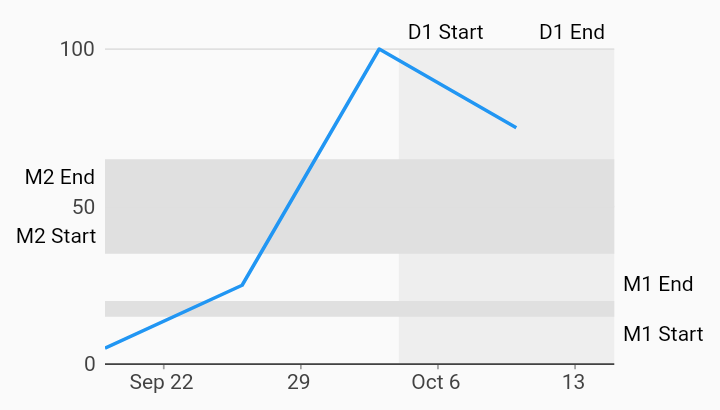community_charts
Range Annotation Margin Time Series Charts Example

Example:
/// Example of a time series chart with range annotations configured to render
/// labels in the chart margin area.
import 'package:community_charts_flutter/flutter.dart' as charts;
import 'package:flutter/material.dart';
class TimeSeriesRangeAnnotationMarginChart extends StatelessWidget {
final List<charts.Series> seriesList;
final bool animate;
TimeSeriesRangeAnnotationMarginChart(this.seriesList, {this.animate});
/// Creates a [TimeSeriesChart] with sample data and no transition.
factory TimeSeriesRangeAnnotationMarginChart.withSampleData() {
return new TimeSeriesRangeAnnotationMarginChart(
_createSampleData(),
// Disable animations for image tests.
animate: false,
);
}
@override
Widget build(BuildContext context) {
return new charts.TimeSeriesChart(seriesList,
animate: animate,
// Allow enough space in the left and right chart margins for the
// annotations.
layoutConfig: new charts.LayoutConfig(
leftMarginSpec: new charts.MarginSpec.fixedPixel(60),
topMarginSpec: new charts.MarginSpec.fixedPixel(20),
rightMarginSpec: new charts.MarginSpec.fixedPixel(60),
bottomMarginSpec: new charts.MarginSpec.fixedPixel(20)),
behaviors: [
// Define one domain and two measure annotations configured to render
// labels in the chart margins.
new charts.RangeAnnotation([
new charts.RangeAnnotationSegment(
new DateTime(2017, 10, 4),
new DateTime(2017, 10, 15),
charts.RangeAnnotationAxisType.domain,
startLabel: 'D1 Start',
endLabel: 'D1 End',
labelAnchor: charts.AnnotationLabelAnchor.end,
color: charts.MaterialPalette.gray.shade200,
// Override the default vertical direction for domain labels.
labelDirection: charts.AnnotationLabelDirection.horizontal),
new charts.RangeAnnotationSegment(
15, 20, charts.RangeAnnotationAxisType.measure,
startLabel: 'M1 Start',
endLabel: 'M1 End',
labelAnchor: charts.AnnotationLabelAnchor.end,
color: charts.MaterialPalette.gray.shade300),
new charts.RangeAnnotationSegment(
35, 65, charts.RangeAnnotationAxisType.measure,
startLabel: 'M2 Start',
endLabel: 'M2 End',
labelAnchor: charts.AnnotationLabelAnchor.start,
color: charts.MaterialPalette.gray.shade300),
], defaultLabelPosition: charts.AnnotationLabelPosition.margin),
]);
}
/// Create one series with sample hard coded data.
static List<charts.Series<TimeSeriesSales, DateTime>> _createSampleData() {
final data = [
new TimeSeriesSales(new DateTime(2017, 9, 19), 5),
new TimeSeriesSales(new DateTime(2017, 9, 26), 25),
new TimeSeriesSales(new DateTime(2017, 10, 3), 100),
new TimeSeriesSales(new DateTime(2017, 10, 10), 75),
];
return [
new charts.Series<TimeSeriesSales, DateTime>(
id: 'Sales',
domainFn: (TimeSeriesSales sales, _) => sales.time,
measureFn: (TimeSeriesSales sales, _) => sales.sales,
data: data,
)
];
}
}
/// Sample time series data type.
class TimeSeriesSales {
final DateTime time;
final int sales;
TimeSeriesSales(this.time, this.sales);
}